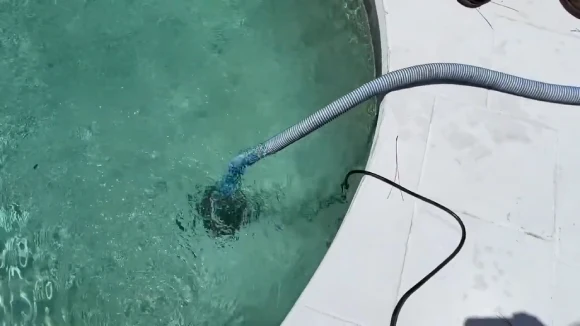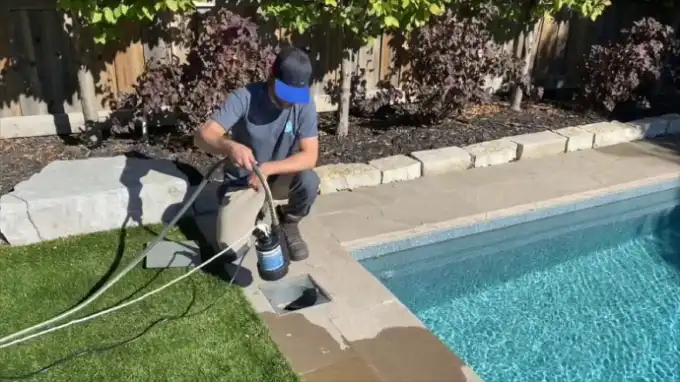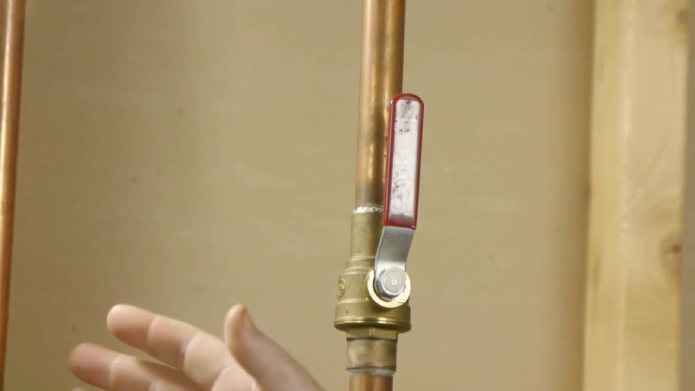Last Updated on June 21, 2023
If you have a pool that needs to be drained for maintenance or cleaning, you may wonder if a sump pump is up for the task. Although sump pumps are commonly used in basements and crawl spaces, they can drain a pool.
However, it’s essential to remember that not all sump pumps are created equal. You’ll want to ensure you have a pump capable of handling the volume of water in your pool.
Most sump pumps are designed for small to medium-sized water removal jobs, so checking the pump’s specifications beforehand is essential.
Also, ensure your sump pump’s hose runs long enough to complete the job. If you need a bit of extra reach, grab an additional discharge hose and ensure it gets drained exactly where you want.
Let’s turn your swimming pool into a crystalline oasis with the help of sump pumps. Discover how these powerful tools can drain away any excess water and keep your favorite dip spot in perfect condition.
Can You Use a Sump Pump to Drain a Pool: What Kind?

Submersible sump pumps are often the go-to option for pool draining, thanks to their efficiency and power. Designed to be submerged directly in the water, these pumps can handle large volumes of water without breaking a sweat.
Their pedestal counterparts, while useful in certain situations, simply can’t match the performance of a submersible pump.
Pedestal sump pumps, on the other hand, are better suited for situations where space is limited or where a vertical float switch is needed.
Since they’re installed outside of the water, they’re not as efficient at pumping water as submersible pumps, and they’re incapable of handling larger volumes of water.
So, don’t get stuck in a draining dilemma. Go with the simple solution of submersible sump pumps to ensure that your swimming pool is always pristine.
Why Should You Use a Submersible Sump Pump to Drain a Pool?

Submersible sump pumps are the go-to choice for draining a pool, and here’s why. They have some major advantages compared to pedestal styles.
1. Efficiency
When draining a pool, submersible sump pumps are the better choice over their pedestal counterparts as they are more efficient.
This is because submersible sump pumps can efficiently pump water at a faster rate compared to pedestal sump pumps. With their superior pumping capabilities, submersible sump pumps can drain your pool quicker and more effectively.
2. Durability
Submerged in water, submersible sump pumps are designed to be more durable compared to pedestal sump pumps.
The corrosive effects of pool chemicals cannot easily damage submersible sump pumps as they are built to withstand such conditions.
As a result, submersible sump pumps can be used multiple times without the fear of them breaking down because of pool chemicals.
3. Safety
Safety is an important factor to consider when draining a pool, and submersible sump pumps provide a safer option over pedestal sump pumps.
As they are underwater, submersible sump pumps don’t face the risk of overheating and starting a fire. This greatly reduces the risk of accidents and increases the safety of the pool cleaning process.
Therefore, it is highly recommended to use submersible sump pumps over pedestal sump pumps when draining a pool.
4. Quiet Operation
When draining a pool, choosing a submersible sump pump over a pedestal sump pump can make a big difference in the noise level.
Submersible sump pumps operate quietly due to their design of being submerged in water, which helps to muffle the sound of the motor.
The less noise that’s produced during the draining process, the fewer disruptions your neighbors will experience. Also, the quieter operation will be less irritating to you, making it easier to work around.
5. Cost-effective
Investing in a submersible sump pump may initially appear to be the more expensive option, but it is a wise decision in the long run.
The increased efficiency, robustness, and safety offered by submersible pumps make them the most cost-effective choice, needing less maintenance and repair.
Unlike pedestal pumps, submersible pumps boast an extended lifespan, ensuring you won’t be replacing them anytime soon. With a submersible sump pump, you can drain your pool or any other water-clogged area without breaking the bank.
6. Ease of Installation
Submersible sump pumps are also easier to install than pedestal sump pumps, making your job much simpler when draining your pool.
Unlike pedestal pumps requiring a separate mounting platform or bracket, submersible pumps can be placed directly into the pool without any additional setup.
This makes them a convenient option for those who want to drain their pool quickly and efficiently without worrying about complicated installation processes.
How to Use a Submersible Pump to Drain Pool Water?

Ready to wave goodbye to murky, cloudy pool water and get your swimming area sparkling clean? Follow these simple steps for crystal-clear draining today, you’ll be an expert in no time.
Step 1: Choose the Right Pump
Before draining pool water, you need to choose the right pump before anything else. It’s important to select a unit that is specifically designed for this purpose, as a pool pump is engineered to handle the demands of moving water with debris, chemicals, and other substances.
Investing in a high-quality pool pump ensures that the water is removed quickly and efficiently, saving you time as well as being easy on your wallet. Also, the pump should have enough power to move large volumes of water with ease.
Step 2: Prepare the Pump
Before diving into draining the pool with a submersible pump, there are important steps to take in preparing. Start by sliding on that long hose, ensuring it fits snugly onto the outlet.
Then secure it firmly with a clamp for optimal performance and make certain your float switch is connected so you don’t have any underwater mishaps. Finally, check that the length of your hose reaches exactly where you need it; no one wants water ending up anywhere unexpected.
Step 3: Connect the Pump to an Electrical Outlet
When utilizing a corded electric sump pump, it is imperative to prioritize safety above all else. To prevent any risk of electrocution, strictly adhere to the instructions provided by the manufacturer and take note of any warnings or precautions.
Be sure to locate an electrical outlet nearby and cautiously plug the pump into it while keeping in mind the electrical capacity requirements specified by the manufacturer to avoid circuit overload.
In the case of a battery-powered model, there is no need to connect it to an electrical outlet.
Step 4: Submerge the Pump
It’s finally time to take the plunge and submerge that pump into the pool water. It’s important to do this step with care and attention, as any mishap could result in damage to the motor.
Ensure that the pump is fully submerged before switching it on, as even a small amount of exposure to air could be detrimental in the long run.
Simply let the pump kick in and begin draining the water, or if it doesn’t, take matters into your own hands and switch it on manually. With this task completed, you’ll be one step closer to enjoying a crystal-clear pool all season long.
Step 5: Turn off the Pump
You need to keep an eye on the water level so that you switch it off once it has reached an acceptable level. Generally, the float switch will automatically shut off the pump when it detects a low water level.
Once the water level has been lowered to the desired level, unplug the electrical outlet, and switch the pump off. It is essential to wait for the pump to stop completely before lifting it out of the water.
Step 6: Disconnect the Hose
Now that the pool is drained and sparkling clean, it’s time to give your trusty pump a break. But before you pack it away until next season, there’s one last step you must take: disconnecting the hose from the pump’s outlet.
Don’t worry, it’s a quick and easy process. Just release the hose clamp, and slide the hose off the outlet.
Make sure you’ve emptied the hose of any remaining water. Otherwise, you might find that it’s become moldy or even unusable next season. Once the hose is emptied and disconnected, just safely store it and the pump away in a dry and secure spot.
What Time Is Required to Drain a Pool Using a Sump Pump?

When draining your pool water through a sump pump, the length of time it takes will depend on several factors. These include the size of the pool, the amount of water in it, and the capacity of the sump pump being used.
A standard sump pump with a 1/3 horsepower motor can pump approximately 30 gallons of water per minute or 1,800 gallons per hour. Therefore, if you have a pool with 20,000 gallons, it could take around 11 hours to drain the entire pool with a single sump pump.
With larger pools, seeing the tide turn could take a while. To get an idea of how long your draining mission will be, consider dividing up that pool’s total water volume versus what your sump pump can realistically handle.
Furthermore, the drain time may be affected by other factors such as the water flow rate from the pump to the drainage location, the depth of the pool, and any potential blockages in the sump pump or plumbing.
Keeping the sump pump clear and well-maintained is important to ensure it functions optimally during draining.
How Can You Identify a Good Quality Sump Pump to Drain Your Pool Water?
To determine a good quality sump pump for draining your pool water, there are several key factors to consider.
Look for a model that offers both powerful capacity and premium materials, like cast iron, stainless steel or thermoplastic. Also, make sure it has an automatic shut-off feature. This is key to keeping your system running smoothly & safely over time.
Trust us, investing in a quality sump pump will pay off in the long run. But if you’re overwhelmed with options, head over to our review article on the best pool sump pumps.
It’s jam-packed with valuable information to help you make an informed choice that’s right for you. Our article covers the specifications and features of the top models, allowing you to compare and contrast different pumps and make a smart decision that aligns with your specific needs.
We also provide our professional recommendations for the best choice. With our help, you can confidently select the best pump for your pool maintenance needs.
How Far Can a Sump Pump Discharge Your Pool Water?

The distance that a sump pump can discharge your pool water depends on several factors, such as the power of the pump, the height of the discharge point, and the diameter and length of the discharge hose.
In general, most sump pumps are capable of discharging water vertically up to 20-30 feet and horizontally up to 100-150 feet. However, this is just a rough estimate, and the actual distance may vary depending on the specific model of the sump pump.
Where Do You Pump Out Pool Water With a Sump Pump?
There are a few options to consider when it comes to pumping out pool water using a sump pump. You can drain your pool into your yard with a sump pump.
Simply connect a hose to the sump pump and place it in the pool, turning on the pump to remove the water. This not only saves you money by reusing water, but it also promotes sustainable water usage by reducing landscape water use. However, it’s important to know any local ordinances regarding pool drainage into your yard.
If you’re looking for another hassle-free way to get rid of pool water, you may consider draining it into your home’s sanitary sewer cleanout.
Just locate your cleanout, hook up the drainage hose, and let the water flow. Certain areas may prohibit draining pool water into the sewer system, so you must check with your local authorities before proceeding.
Drain Pools Efficiently & Safely: Choose the Right Submersible Sump Pump
Sump pumps have become a go-to solution for their efficiency and ability to save time when it comes to draining pesky pools.
However, it’s important to ensure you select a sump pump with sufficient power to get the job done. Safety and longevity are also crucial factors to consider, which is why a submersible sump pump is non-negotiable.
You also need to pay attention to the discharge hose’s length to ensure it can reach your preferred drainage location.
When everything falls into place, you can trust that your sump pump will take care of draining out the pool.



